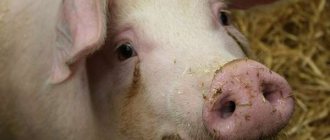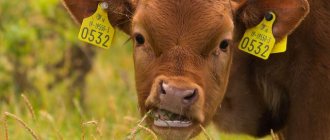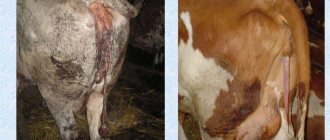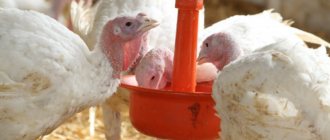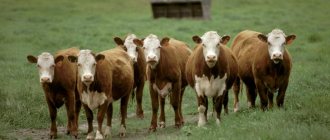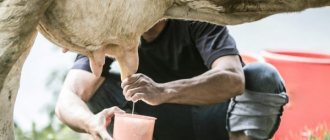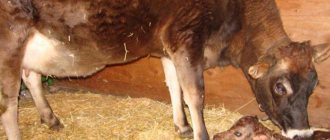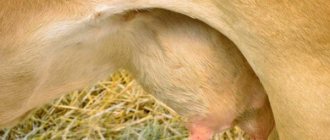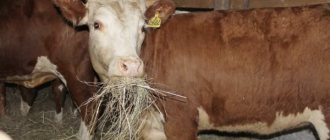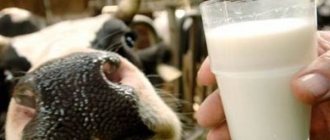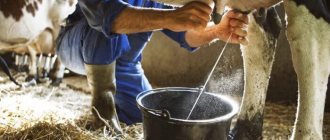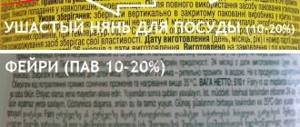How can a cow get poisoned?
A cow is a large horned animal. A cow that produces milk requires careful supervision and care. Poisoning occurs as a result of harmful and toxic substances entering the body.
The cow's intestines have a certain structure and insufficient resistance to bacteria and viruses. Therefore, poisoning occurs frequently. There are several factors and causes that can cause poisoning in such animals.
Factors:
- An ingested substance used in fields to get rid of harmful insects and weeds;
- Use of low quality feed;
- Eating poisonous plants, berries, mushrooms, green potatoes;
- Ingestion of alfalfa, corn shoots and various plants harmful to the cow;
- Herbs containing alkaloids - henbane, horsetail, buttercup - also pose a health hazard, in some situations even treatment will be useless;
- Poisoning is caused by salts of heavy metals; if treatment is started in time, the animal can be saved.
In most cases, intoxication occurs due to the cow eating harmful substances and plants. When grazing, the shepherd must watch what the livestock eats.
What can cause intoxication in cows and calves? What foods should you exclude from your diet and make sure they don’t get into your food?
Chemical poisoning
Livestock can also be poisoned by pesticides. If disinfection was carried out in the barn, then before bringing a herd of cattle into it, the room should be well ventilated, handrails, feeders, drinkers and the floor in the stalls should be washed. After treating the premises, be sure to change the litter, wash the feeders and drinkers.
More on the topic: Symptoms and methods of treating acidosis in cows
| № | Helpful information |
| 1 | Chlorine-containing products and lime are toxic substances. They have a negative effect on the animal body. They experience gastrointestinal upset, the functions of the endocrine glands are disrupted, and the respiratory system suffers. Lethal dose for cattle – 1 g per 1 kg of weight |
| 2 | Animals can also consume chemicals on pasture if the plants have been treated with nitrates. The substances act on the nervous and circulatory systems. In animals, blood pressure sharply decreases, oxyhemoglobin turns into methemoglobin: the body experiences oxygen starvation. The death of the animal occurs quickly. The lethal dose of nitrate for cattle is 100 g, nitrite – 25 g |
| 3 | Mercury salts are part of the substances used to treat plant seeds and cereal grains. Salts produce a disinfecting effect. If grain processing technology is violated, large amounts of mercury accumulate in feed. Poisoning in cattle has the following symptoms: Hemorrhage occurs in the oral mucosa. The mucous membrane has an inflamed red color. Animals feel weak and lie with their legs extended. They can't get up. The pulse is thready, the pressure is low. There is profuse salivation. The animal dies if first aid is not given to it. |
Calves and adult animals must be given table salt and feed phosphate. The amount of food additives is strictly prescribed. Exceeding the norm of salts in the diet leads to poisoning of animals. Calves experience increased excitability, which is replaced by a depressed state. Animals become violent and constantly run into objects when moving.
Igor Nikolaev
auto RU
If you don't get help, the toxins will attack the muscles. At first the animals will not be able to stand on their feet, then cardiac arrest occurs. Such symptoms appear at a dosage of table salt of 4 g per 1 kg of live weight.
Sugar beets and sugar
Both products in large quantities provoke excessive formation of lactic acid and sugar. As a result, the cow develops acidosis and hyperglycemia. Sugar beet poisoning leads to disruption of the heart and stomach, and the development of hemorrhagic gastroenteritis.
You will like the article: Poisoning of pigs - rat poison, table salt, mustard, pesticides and protein .
Nitrate, various pesticides and other chemicals pose a danger to cows. An animal can be poisoned intentionally by mixing a toxic substance with food. It is possible to be poisoned by rat poison used to kill rodents. Any farmer must be careful about the diet of cows to avoid intoxication.
Signs and symptoms of intoxication
What are the signs of intoxication?
The first symptoms begin to appear a few hours after the toxin penetrates inside. Calf poisoning is diagnosed earlier due to the rapid spread of poisons. At this stage, it is important to begin treatment to avoid the death of the animal.
We recommend: What to do if your dog is poisoned by rat poison?
Signs:
- Change in the color of stool, the presence of mucus, foam, blood in them;
- Bloated belly;
- Vomiting, nausea;
- Increased body temperature;
- Uneven gait, lack of coordination;
- Depressed state, apathy, lack of movement in the animal;
- The pupils become narrow or wide;
- Strong separation of saliva or, conversely, dry mucous membranes;
- The oral cavity changes color depending on what substance was the toxin;
- Impaired functioning of the cardiac system, difficulty breathing;
- The presence of convulsive manifestations, changes in emotional state, psychosis, aggression.
The presence of at least one sign should alert the farmer. Treatment of the cow must be started immediately to avoid negative consequences.
First aid and treatment methods
What to do in case of poisoning? The owner of the animal calls the veterinarian and describes all the signs. Before the doctor arrives, the injured cow is given first aid to remove the harmful substance and alleviate the condition.
Help:
- Depending on what substance provoked the poisoning, an antidote is administered.
- In all cases, gastric lavage is required to remove the toxin. For this purpose, it is permissible to use a probe, if available.
- In cases of chemical poisoning, a hole is pierced into the side of the cow's abdomen to puncture the rumen.
- They give plenty of water, it is permissible to use laxatives and administer glucose.
The doctor is called in any case, even if the procedures performed gave a positive result and the cow felt better. Be sure to tell the veterinarian about the actions taken and explain what caused the poisoning.
What to do, how to treat
If it has been established that a chemical substance has entered the cow’s body, then emergency treatment will follow in the form of injections that will have an antitoxic effect. Such therapy can only be carried out by a veterinarian who knows exactly what substance the cow was poisoned with and what antidote needs to be administered to her.
First aid
When providing emergency assistance after poisoning with urea and nitrates, the animal's side of the abdomen is pierced and the scar is pierced. In other cases, various “antidotes” are administered - antidotes, absorbents, the stomach is washed, laxatives are given, glucose and saline are injected into a vein.
For poisoning with various substances, treatment regimens will be as follows:
- When eating poisonous herbs. It is necessary to introduce up to 2 liters of a 0.5% acetic acid solution into the cow’s stomach as quickly as possible and rinse the stomach with a 0.1% solution of potassium permanganate. The animal is also injected with glucose and a 10% solution of methenamine.
- When mercury enters the body. Strizhevsky's antidote is administered. Further treatment of poisoning will consist of feeding the animal milk, mucous and protein decoctions.
- When eating food with nitrates. The stomach is washed and a 1% solution of methylene blue is administered.
- When copper salts enter the body. Rinsing is done with a mixture of water and charcoal and glucose is introduced.
- When eating arsenic. The stomach is washed with a 1% solution of burnt magnesia. After this, the cow is soldered with milk and oily emulsions, which will allow the formation of a film in the digestive tract and renew the mucous membrane.
- With excessive consumption of beets. It is necessary to rinse as soon as possible with a weak solution of potassium permanganate, inject insulin subcutaneously, which will reduce blood sugar levels, and also inject a 5% sodium chloride solution into a vein.
- When taking substances that have a depressant effect on the nervous system. Caffeine injections are used.
- When taking substances that have a stimulating effect on the nervous system. Injections of chloral hydrate are used.
Did you know? The record for annual milk production belongs to a Holstein cow named Juliana. In 2004, she produced 30,805 kg of milk per year. And milk with a record fat content was recorded in England - 14.06%.
Further therapy
After emergency methods have eliminated the threat to the animal’s life, the veterinarian will write detailed instructions on how the owner should proceed further.
The duration of therapy and the cow’s recovery will depend on how severely the body is affected.
The classic treatment regimen is as follows:
- Ensuring complete rest for the “patient”.
- For the first 2 days, the animal is given only a lot of water. No food has been introduced yet.
- From the very first day, sorbents are soldered on, allowing you to cleanse the body of toxins.
- On the third day, you can offer the cow gentle liquid food - flour or oatmeal.
- The return to the normal diet is done gradually - each ingredient is added daily in small portions, monitoring how the digestive system reacts to such addition.
Important! To avoid dehydration, the cow must be offered plenty of water at all times.
Treatment methods for cows
When treating intoxication, a set of procedures and medications are carried out to restore the health of the cow. The medications are prescribed by a doctor; it is not permissible to use medications on your own.
Preparations:
- Sorbents for cleansing of toxins. Use white clay and activated carbon. If the toxic substance has already been absorbed into the blood, such remedies will not help.
- Introduction of antidotes. Choose a suitable remedy to neutralize the effect of the poison.
- Caffeine. Helps restore the normal state of the nervous system.
- Glucose solution eliminates diarrhea, nausea, and helps avoid dehydration.
- Laxative medications cleanse the intestines of toxins.
- If necessary, additional antidotes are used to eliminate the effects on organs and systems of the toxic substance.
We recommend: Dog isoniazid poisoning - emergency care, symptoms and treatment methods
How to start the stomach of an injured cow? During the recovery period, you need to be careful about the animal’s diet and ensure that toxic substances do not get into the food. With timely assistance and proper treatment, recovery occurs quickly.
What to do if you are poisoned by plants?
Farmers give different recipes on their forums if a cow is poisoned. What should you do before calling the vet? First aid is aimed at reducing intoxication of the body and removing the poisonous plant from the body. Treatment depends on the type of plant the animal has eaten. In case of poisoning, wash the stomach.
- For this, a 2.5 m probe with a diameter of 40 mm is used. It is injected into the scarred part of the stomach through the esophagus.
- Pour 2 buckets of water through the probe.
- The contents of the rumen are also removed through a probe.
- Pour in 4 buckets of water.
- Perform scar massage through the peritoneum. During the massage, fluid is removed from the rumen in a strong stream. Grass particles are removed along with the water.
The water used for washing is heated to a temperature of 40 degrees. Often, instead of water, a 2% soda solution is used. Washing the rumen is used not only for poisoning, but also for blockage of the rumen and atony of the proventriculus.
- In addition to rinsing, in case of poisoning, caffeine is administered intravenously, 20% solution, amount 10 ml.
- A 40% glucose solution is used and 300 ml is administered intravenously.
- Animals are given “Tannin” internally. The drug has binding and tanning properties. It will reduce intoxication of the body. Single dosage 20 ml.
- Glauber's salt is given as a laxative: 800 g dissolved in water. If there is no laxative, then castor oil is administered through the tube.
- For convulsions, animals are administered chloral hydrate: solution 1%, 20 ml.
- For paralysis, strychnine nitrate is administered. The drug belongs to group “A”. Only a doctor can prescribe it.
After gastric lavage, administration of laxatives, and after first aid, the animal is given rumen-enveloping agents. They will reduce the absorption of toxic substances into the blood. Ordinary starch can act as an enveloping agent. The mixture is easy to prepare yourself:
- mix 1 part starch and 5 parts cold water;
- introduce the solution into boiling water: take 50 parts;
- boil for 8 minutes;
- cool;
- give the cow a drink.
In case of paralysis of the masticatory muscles, all solutions are injected into the stomach of animals through a tube. Instead of starch, you can give milk. Enveloping agents are given for diarrhea. If a cow is poisoned by sorrel, an additional chalk solution is injected into the stomach. Intravenous injections of calcium chloride are given.
Prevention during intoxication
Every farmer knows the symptoms and treatment of cow poisoning. It is possible to avoid poisoning of cattle by following preventive measures. Taking good care of your cow will help you stay healthy.
Measures:
- In spring, do not leave hungry animals unattended, do not let them out into places where buttercups grow.
- Do not graze after a drought; during this period, toxin accumulates in the grass.
- After the animals return from pasture, all the grass is mowed, the cows do not eat poisonous plants, leaving them on the fields.
- The food needs to be carefully inspected and food with mold or bad odor should not be given to the cow.
- Food should not contain herbs after treatment with chemicals.
Prevention of poisoning in cows
The likelihood of poisoning in a cow can be minimized by following simple preventive measures. They include a set of measures and help maintain the health of the cow.
Basic rules for preventing poisoning:
- store food in a dry, well-ventilated area to prevent it from becoming moldy;
- do not let the cow go to pastures located near farmland treated with chemicals;
- store potatoes correctly, preventing the formation of solanine in them;
- when preparing hay, carefully inspect the pasture for poisonous plants;
- graze cows in safe areas where chemicals have not been used and there are no potentially dangerous crops;
- daily consumption of sugar beets should not exceed 12 kg per adult cow;
- Carry out a thorough check of the feed at the stage of procurement and purchase, paying attention to the composition, consistency, humidity, as well as the presence of parasites and moldy fungi;
- After using chemicals, dispose of the packaging, preventing harmful components from entering rivers, lakes and other places where cows water.
